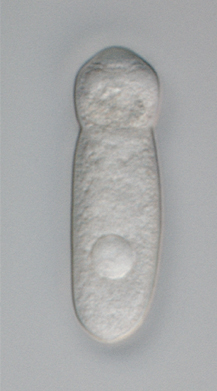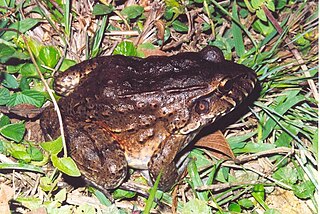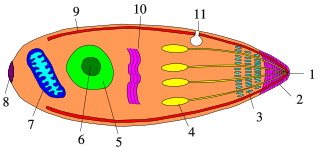
Eimeria is a genus of apicomplexan parasites that includes various species capable of causing the disease coccidiosis in animals such as cattle, poultry and smaller ruminants including sheep and goats. Eimeria species are considered to be monoxenous because the life cycle is completed within a single host, and stenoxenous because they tend to be host specific, although a number of exceptions have been identified. Species of this genus infect a wide variety of hosts. Thirty-one species are known to occur in bats (Chiroptera), two in turtles, and 130 named species infect fish. Two species infect seals. Five species infect llamas and alpacas: E. alpacae, E. ivitaensis, E. lamae, E. macusaniensis, and E. punonensis. A number of species infect rodents, including E. couesii, E. kinsellai, E. palustris, E. ojastii and E. oryzomysi. Others infect poultry, rabbits and cattle. For full species list, see below.

The gregarines are a group of Apicomplexan alveolates, classified as the Gregarinasina or Gregarinia. The large parasites inhabit the intestines of many invertebrates. They are not found in any vertebrates. Gregarines are closely related to both Toxoplasma and Plasmodium, which cause toxoplasmosis and malaria, respectively. Both protists use protein complexes similar to those that are formed by the gregarines for gliding motility and for invading target cells. This makes the gregarines excellent models for studying gliding motility, with the goal of developing treatment options for both toxoplasmosis and malaria. Thousands of different species of gregarine are expected to be found in insects, and 99% of these gregarine species still need to be described. Each insect species can be the host of multiple gregarine species. One of the most-studied gregarines is Gregarina garnhami. In general, gregarines are regarded as a very successful group of parasites, as their hosts are distributed over the entire planet.

Leucocytozoon is a genus of parasitic alveolates belonging to the phylum Apicomplexa.

Leptodactylus labyrinthicus is a species of frog in the family Leptodactylidae. Its common names are labyrinth frog, pepper frog, South American pepper frog, and pepper foam frog. This frog is found in central and southeastern Brazil, northeast Argentina, and eastern Paraguay. Earlier reports from Bolivia refer to Leptodactylus vastus, or possibly an unnamed species.
Leptodactylus pustulatus is a species of frog in the family Leptodactylidae. It is endemic to Brazil. Its natural habitats are moist savanna, subtropical or tropical moist shrubland, freshwater marshes, pastureland, rural gardens, urban areas, and ponds. The female frog seems to provide some level of parental care for the tadpoles. This is a common species of frog and the International Union for Conservation of Nature has listed it as being of "least concern".

Lithodytes is a genus of frogs in the family of Leptodactylidae. It is monotypic, being represented by the single species, Lithodytes lineatus, also commonly known as the gold-striped frog or painted antnest frog. It is found in tropical South America where it lives in humid forests among the leaf litter. These frogs build foam nests at the edge of temporary pools, and the tadpoles develop within these. The frogs also associate with certain leafcutter ants and breed inside their nests without being attacked by the ants.

Piroplasmida is an order of parasites in the phylum Apicomplexa. They divide by binary fission and as sporozoan parasites they possess sexual and asexual phases. They include the tick parasites Babesia and Theileria.

Adeleorina is a suborder of parasites in the phylum Apicomplexa.
Eimeriorina is a suborder of phylum Apicomplexa.

Apicomplexans, a group of intracellular parasites, have life cycle stages that allow them to survive the wide variety of environments they are exposed to during their complex life cycle. Each stage in the life cycle of an apicomplexan organism is typified by a cellular variety with a distinct morphology and biochemistry.
Anthemosoma is a genus of parasites of the phylum Apicomplexa. There is only one species recognised in this genus - a parasite of mammals.
The genus Schellackia comprises obligate unicellular eukaryotic parasites within the phylum Apicomplexa, and infects numerous species of lizards and amphibians worldwide. Schellackia is transmitted via insect vectors, primarily mites and mosquitoes, which take up the parasite in blood meals. These vectors then subsequently infect reptilian and amphibian which consume the infected insects. The parasites deform erythrocytes of the host into crescents, and can be visualized using a blood smear.
Lankesterella is a genus in the phylum Apicomplexa. Species in this genus infect amphibians, reptiles and birds.
The Caulleryellidae are a family of parasites in the phylum Apicomplexa. Species in this family mostly infect dipteran larvae.
The Syncystidae are a family of parasitic alveolates in the phylum Apicomplexa. Species in this family infect insects (Aeshnidae).
The Schizocystidae are a family of parasitic alveolates in the phylum Apicomplexa. Species in this family infect insects.
Mattesia is a genus of parasitic alveolates of the phylum Apicomplexa. Species in this genus infect insects.
Syncystis is a genus of parasitic alveolates in the phylum Apicomplexa.
Schizocystidae is a genus of parasitic alveolates in the phylum Apicomplexa.
Lipocystis is a genus of parasitic alveolates of the phylum Apicomplexa.







